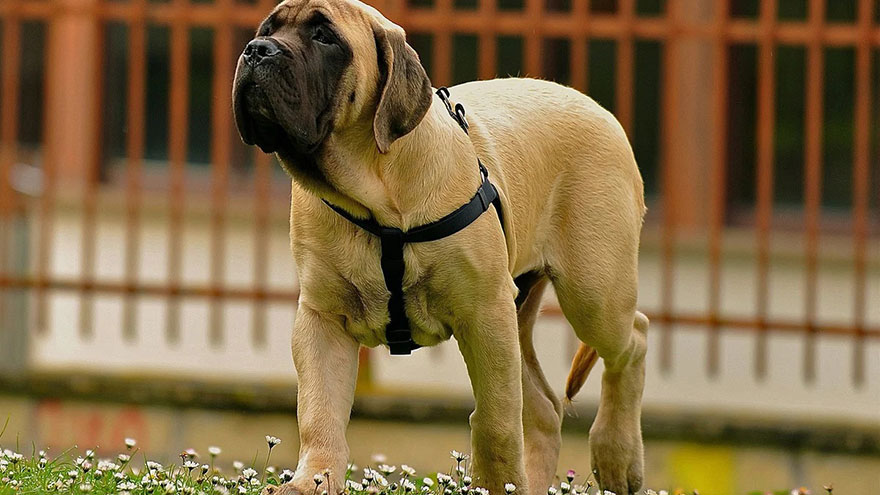English Mastiff : 10 Most Common Questions
The Mastiff is a very large, impressive breed that attracts attention because of its appearance. However, owners soon find that the Mastiff is a gentle, good-natured animal that fits in well with the family environment.
Keep in mind that some people may find the size and strength of this dog more than they bargained for so it is important to be prepared to own a larger breed dog. To help answer some of the questions you may have about this wonderful breed, we have gathered some of the top questions and answers.

1. What is the background of the Mastiff?
The Mastiff is descended from the ancient Alaunt and Molosser. Interestingly, the name Mastiff specifically refers to the English Mastiff or Mastiff. Similar dogs from other countries or areas of Europe are separate breeds, not to be confused with this Mastiff.
The evidence of a Mastiff goes back nearly 3,000 years with some evidence being found in the Middle East and the Mediterranean Sea region.
2. How big does the Mastiff get?
The male of the Mastiff breed can reach 32 inches or taller at the shoulder and weigh 175 pounds or more. Some individual dogs may grow to 36 inches tall and weigh well over 200 pounds. The female of the breed, though a bit smaller, still weighs about 150 pounds.
3. Will my Mastiff do well in the house?
This gentle and undemanding breed actually does quite well in the house. Just keep in mind that because of its large size, challenges may be presented in a smaller home. This breed loves to lie near or at the feet of its owner, even wanting to sleep on the sofa when young.
However, because the breed grows so large, we recommend you establish some “off limit” places while still young. The Mastiff is also highly intelligent.
4. Will I be able to afford to feed my Mastiff?
Affordability would probably not be as much of a problem as you think because the breed generally eats only about as much as a dog that is a bit smaller, such as the German Shepherd.
If you establish a diet of a high-quality commercial food, and get some input from your veterinarian, you should be just fine.
5. Do Mastiffs become aggressive when they grow older?
Any well-socialized and well-bred dog should not be a problem when it comes to aggression or excessive barking. Now, the Mastiff is naturally protective of the family and home. However, most do not show great aggression toward strangers.
Some individual dogs may be a bit aggressive toward other adult Mastiffs, but this is something that can be limited with proper training and a good relationship between the owner and the Mastiff.
6. Does the Mastiff need much exercise?
The Mastiff is a very deliberate animal, doing well with occasional exercise and walks. The breed is not full of energy, as many small dogs would be, but even so, you should be prepared to provide your Mastiff with some daily exercise to keep it healthy, happy, and lean. It is also important not to over-exercise the young Mastiff, as the bones develop.
The Mastiff skeleton needs to be very strong and healthy to support the weight of the body, so it is important to give the young dog time to grow without stressing the bones and muscles too much.
7. Does the Mastiff drool?
Yes, it can so you might consider keeping a towel handy to wipe up the occasional drool from the mouth. Most of the time, drooling is caused by a recent drink of water or by a situation in which the dog is very stressed or agitated. Of course, the smell of food can also trigger this.
8. How long does a Mastiff live?
Like many large dogs, the Mastiff has a shorter lifespan than smaller dogs. You should expect your healthy Mastiff to live about 10 years, although some have lived as long as 14 to 16 years. As with any pet, the lifespan depends on the overall health, diet, and exercise, as well as being free from genetic diseases and conditions.
9. What color Mastiff should I look for?
The Mastiff usually has just a single color coat that is an apricot shade or various shades of fawn. In addition, some are brindled or tawny, brownish with some evidence or streaks of other colors. Most groups and associations consider white in the coat a fault.
10. What are some genetic health problems I should be aware of with the Mastiff?
With large dogs, hip dysplasia is always something of which you should be concerned. Therefore, ask your breeder about this condition and OFA certification, showing the puppy free from hip dysplasia.
You should also get information about progressive retinal atrophy, entropion, and hypothyroidism.
Read More About English Mastiff
- English Mastiff Breed Information
- English Mastiff Training Guide
- English Mastiff Health Guide
- Owning a English Mastiff : Breeder Recommendations

